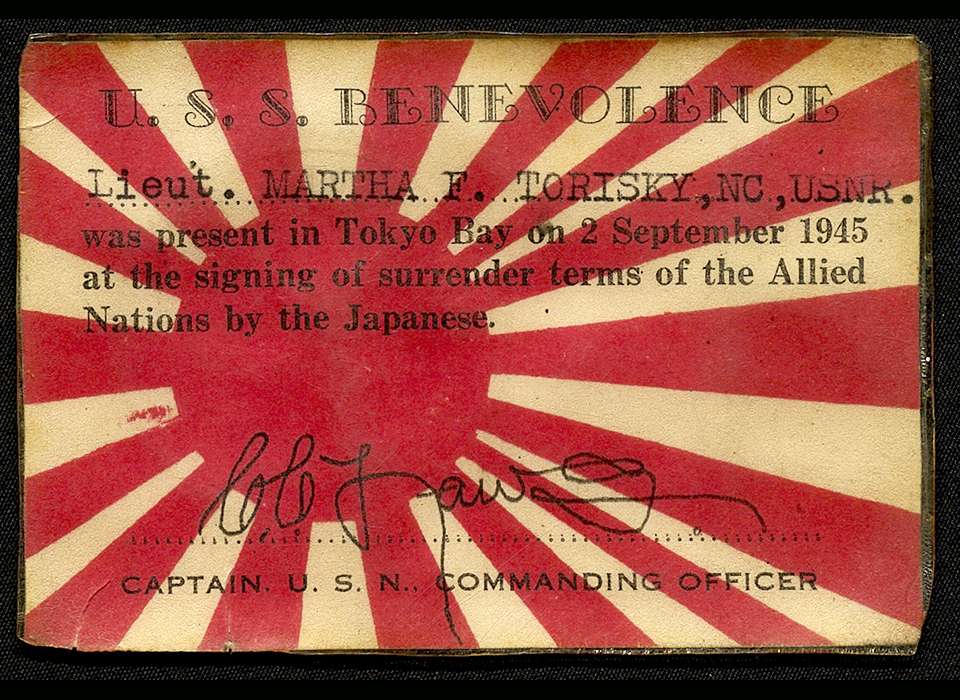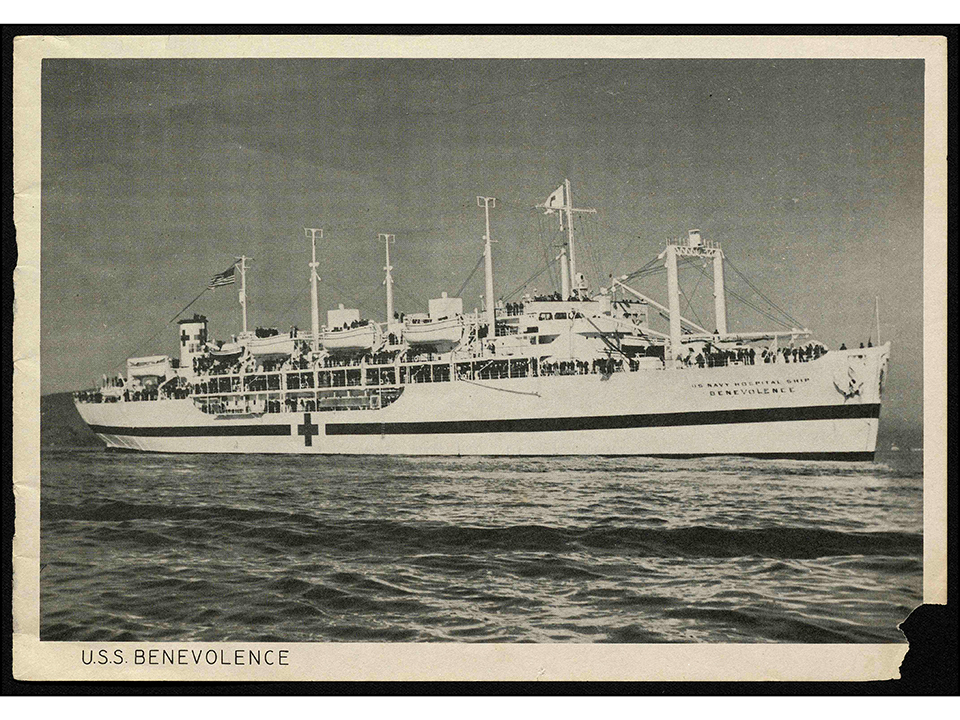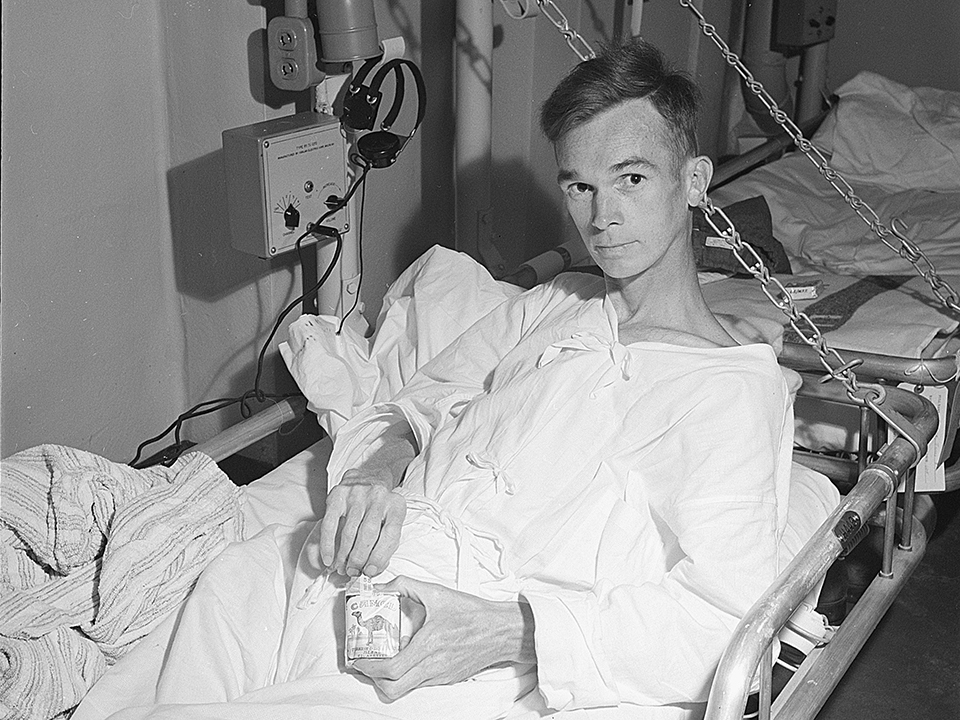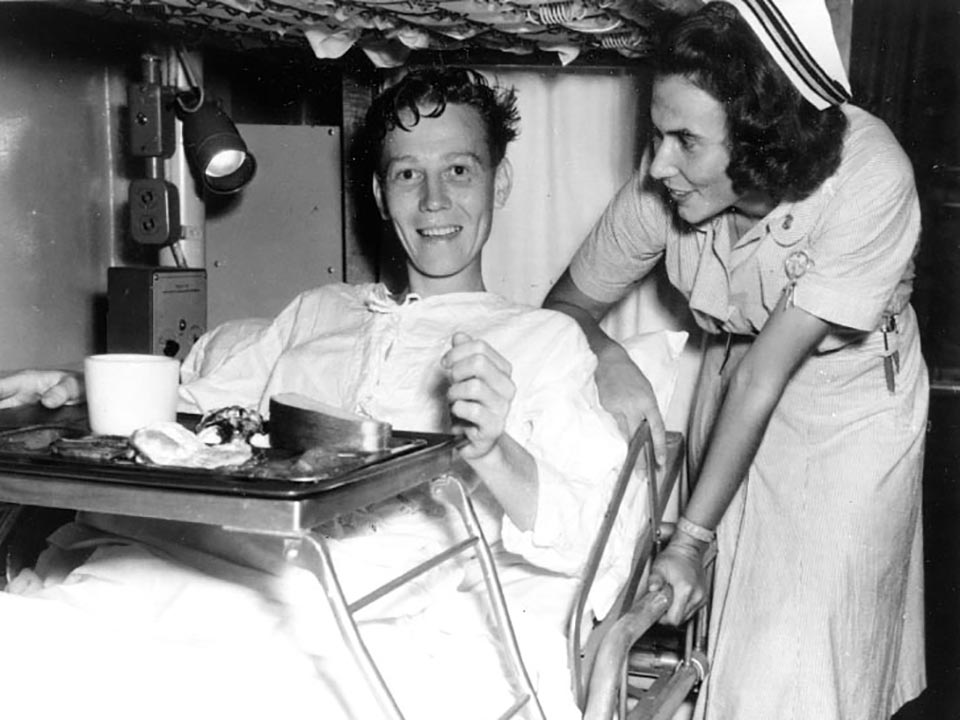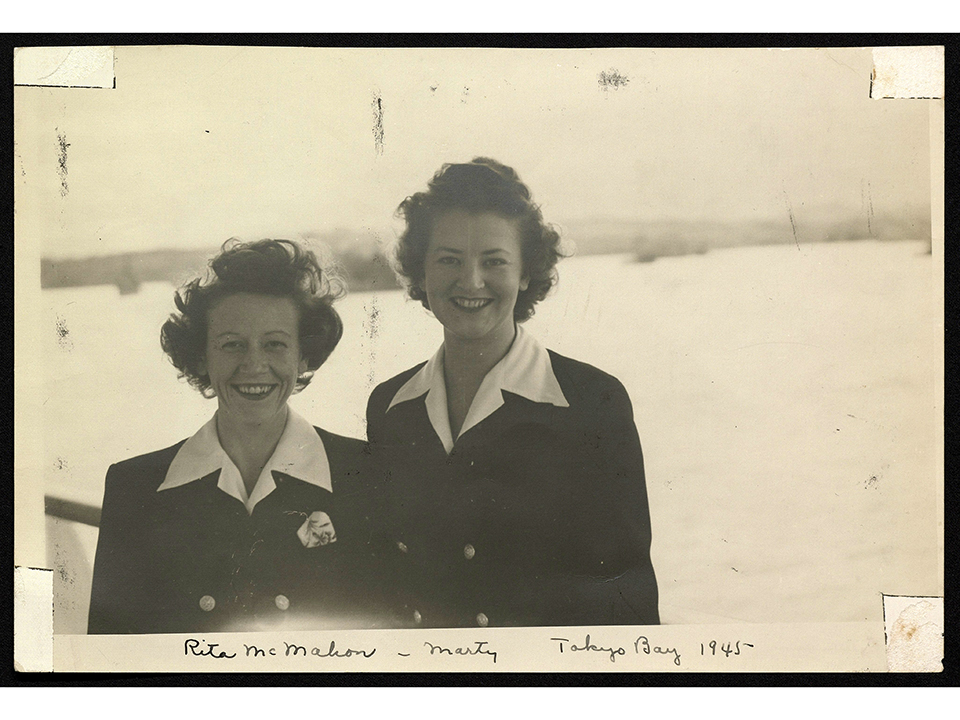The impressive 300-vessel display of Allied naval power in Tokyo Bay assembled for the Japanese surrender aboard the USS Missouri on September 2, 1945 included three US hospital ships. One was Army-operated—the USAHS Marigold and the others were the Navy ships, USS Rescue and USS Benevolence.
The very end of the war saw a tactical shift in the deployment of hospital ships. Initially, they were used as floating ambulances intended to “scoop and sail,” to ferry the wounded from the battlefront to a facility onshore. Later, as combat losses mounted and injuries soared, they became active combat care units. Beginning with the invasion of Iwo Jima, Halsey ordered early, forward use of hospital ships to treat and stage the wounded aboard. Hospital ships used in this way, as operating theaters, allowed for a quicker return-to-duty rate and higher retention of the fighting strength.
When the Japanese attacked Pearl Harbor, the US Navy had only two hospital ships in service. Due to disagreements over availability and use of these vessels, the Army established its own fleet of hospital ships for use in the Atlantic and Mediterranean. The distances of the Pacific and the insufficient number of specially-outfitted craft remained a problem in the early war years, but by October 1944, additional resources were made available as hospital ships were transferred to the Pacific Fleet and others were newly-commissioned.
The proximity of hospital ships to combat operations was tricky for several reasons. Under the protections of the Geneva and Hague Conventions, hospital ships painted white and marked with the Red Cross, were to be sheltered from enemy fire. As protected vessels, the hospital ships were also under orders to remain lit at all times. So within a group of other un-protected vessels, they could be subject to accidental hits—or they could draw fire to nearby unprotected ships by their lights. One hospital ship, the USS Comfort was subject to a kamikaze attack off Okinawa on April 28, 1945, killing 17 in the surgery unit. Even still, the forward deployment of hospital ships during the latter campaigns of the war proved successful.
By the end of the war, the US Navy operated 15 hospital ships. The USS Benevolence (AH-13) was new to the “mercy fleet,” commissioned on May 12, 1945. Todd Shipyard in Brooklyn converted the cargo ship SS Marine Lion into a fully outfitted and air-conditioned floating hospital. She had a bed capacity of 802 patients with the ability to increase. The crew consisted of 58 officers, 30 nurses, two Red Cross workers, 24 chief petty officers, 230 crew members, and 238 hospital corpsmen. The Benevolence and other Haven-class ships featured increased numbers of hoists and ladders to take wounded aboard, ready rooms for treating shock patients, and also laboratories. The air-conditioning throughout the hospital and crew’s spaces was particularly revolutionary; they were the first Navy vessels to feature this modern convenience. They also featured four operating rooms, a dental clinic, physiotherapy and radiography rooms, and a neuropsychiatric unit. They contained lounges and recreation facilities for the patients. Adding to the patients’ comforts was an in bed/berth entertainment system, almost like that of modern airplanes, described as “ear phones or pillow phones hooked into a five-channel entertainment broadcast system. A master receiving set will provide long and short wave radio programs. Phonograph music will be carried over the ship’s hookup.” The nurses’ quarters, referred to as “nurse’s country,” was a self-contained area with a separate mess. Each floating hospital also carried a packed and crated field hospital, which could be established on shore. For this purpose, they also carried a station wagon and ambulance, which had to be maintained during the voyage.
The Benevolence left Pearl Harbor on July 6, 1945 with Captain C.C. Laws as the Commanding Officer and Capt. F.L. McDaniel, the Senior Medical Officer. They sailed to the Pacific without an escort until Eniwetok, where on July 26, they received their first patients. When embarking patients, the Admitting Officer would make a quick diagnosis on deck and assign the patient to one of the ship’s wards. On August 12, they left the Marshall Islands to join the Third Fleet, with the aim of treating troops in the upcoming invasion of Japan. When the atomic bombs were dropped, their mission changed. Instead of tending to casualties, their primary focus was to evaluate and treat liberated prisoners of war, most of whom had spent three long years in Japanese captivity.
On August 29, 1945, the Benevolence and two other hospital ships, the USS Rescue and USS Tranquility, entered Tokyo Bay with the Third Fleet. The waters were still unsecured. Mines had been cut loose from their chains by the Japanese and floated untethered in the bay; danger afloat. Even later, during the surrender ceremony, there were fears that the event could be subject to kamikaze attack.
After only a few hours in Tokyo Bay, the hospital ships began to receive their patients. Rear Admiral Arlene Duerk, one of the Navy’s first female Admirals and Chief of the Navy Nurse Corps from 1970-1972, was a nurse aboard the first voyage of the Benevolence. She recalled processing patients for 36 hours straight. After their ship was full, they transferred them to other ships. First stop aboard was a decontamination ward; the ambulatory patients were instructed to strip naked and shower, they were then treated with disinfectants and deloused and issued new uniforms. Some of the men who had been POWs for years were reluctant to give up clothes they had just received from B-29 supply drops after having been in captivity so long without sufficient clothing. Debriefing interviews by military intelligence officers took place and the refeeding process began, accompanied by TLC (actually prescribed in regulations.) Sgt. Ferdinand Spacal from Chicago, 20th Air Force POW, arrived on the Benevolence on August 29. He reported in a letter, “That ship ‘Benevolence’ sure is swell and up to date in all respects.” The Benevolence processed thousands of patients including British Lt. General Arthur Percival and General Jonathan Wainwright as well as several other Medal of Honor recipients including Admiral Richard O’Kane and Major “Pappy” Boyington.
Former POW Cpl. Leopold Anthony Mulikowski of Muskegon, Michigan on the USS Benevolence, August 30, 1945. Mounted behind him is the “pillow phone” entertainment system. Official US Navy Photograph.
Navy Nurse Dorothy Davis, from the USS Rescue, recalled treating the POWs, “It was an interesting experience, though heartbreaking at times, to learn that the elderly-looking, emaciated gentleman before you was a boy in his twenties…” A ship history from the Benevolence notes of the arrival of the newly-liberated men, “Seeing, with our own eyes, these victims of Japanese atrocities, their thin and emaciated bodies, but happy faces (these people—the heroes of any war)—All of us, our thoughts, WHAT PRICE THIS GLORY?”
The patients and crew of the Benevolence were among the thousands who witnessed General Douglas Macarthur declare his hopes for a better world in the 23-minute ceremony on September 2nd. Navy Nurse Ethel Buler said that day aboard the Benevolence was one of the highlights of her career. She recalled, “The Benevolence was docked to the port side of the Missouri and we were able to see the ceremony with the aid of binoculars. Peace at last!” Former POW and patient Sgt. Ferdinand Spacal later wrote a friend, “...I suppose you listened to Japans [sic] surrender on Sept. 2...We all did from the ‘Benevolence’ while still in Tokyo Bay and sure enjoyed it, too, that was indeed a great day!”
Although most of the other vessels departed in the days and weeks following, the Benevolence stayed on in Tokyo Bay until November, serving as the hospital for the 3rd and 7th Fleets in Yokohama. She returned home in December 1945 and witnessed another legendary event in June 1946, Operation Crossroads at Bikini Atoll. On August 25, 1950, preparing to support Korean War troops, the Benevolence collided with another vessel in heavy fog near San Francisco, sinking with a loss of 23 individuals.
Hear oral histories from former POWs who were treated aboard the USS Benevolence.
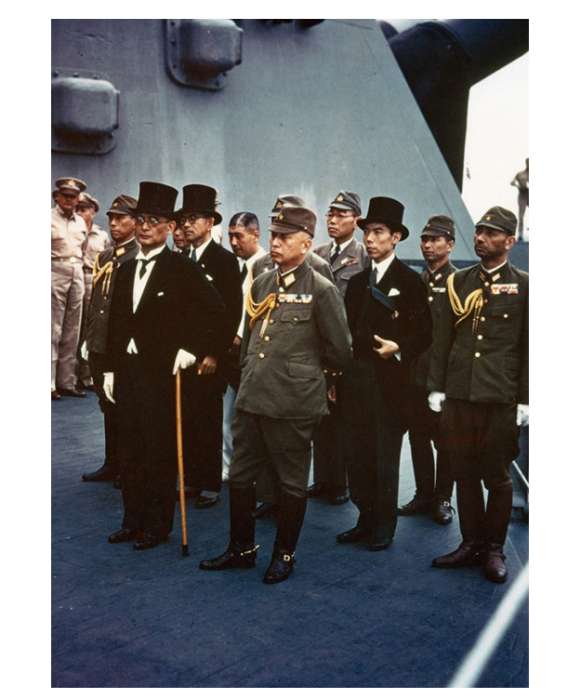
Full Circle: The Japanese Surrender in Tokyo Bay, September 2, 1945
Every aspect of the Japanese surrender on board the USS Missouri was carefully choreographed, with one eye on the past and another on the future.
This article is part of an ongoing series commemorating the 75th anniversary of the end of World War II made possible by Bank of America.
Kim Guise
Kimberly Guise holds a BA in German and Judaic Studies from the University of Massachusetts Amherst. She also studied at the Universität Freiburg in Germany and holds a masters in Library and Information Science (MLIS) from Louisiana State University. Kim is fluent in German, reads Yiddish, and specializes in the American prisoner-of-war experience in World War II.
Cite this article:
MLA Citation:
APA Citation:
Chicago Style Citation:
